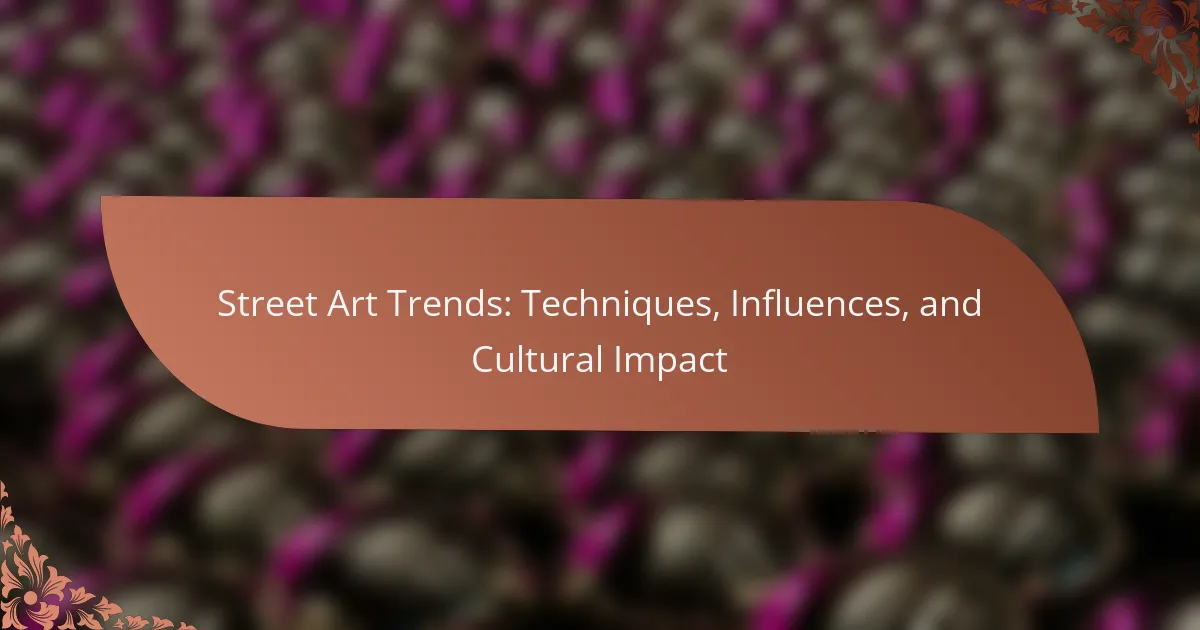Street art trends reflect cultural influences and social issues, shaping urban landscapes. This article explores contemporary techniques like stenciling and spray painting, the cultural impact on communities, and the challenges artists face. It also examines how digital platforms are transforming street art and addresses common misconceptions about its value and purpose.
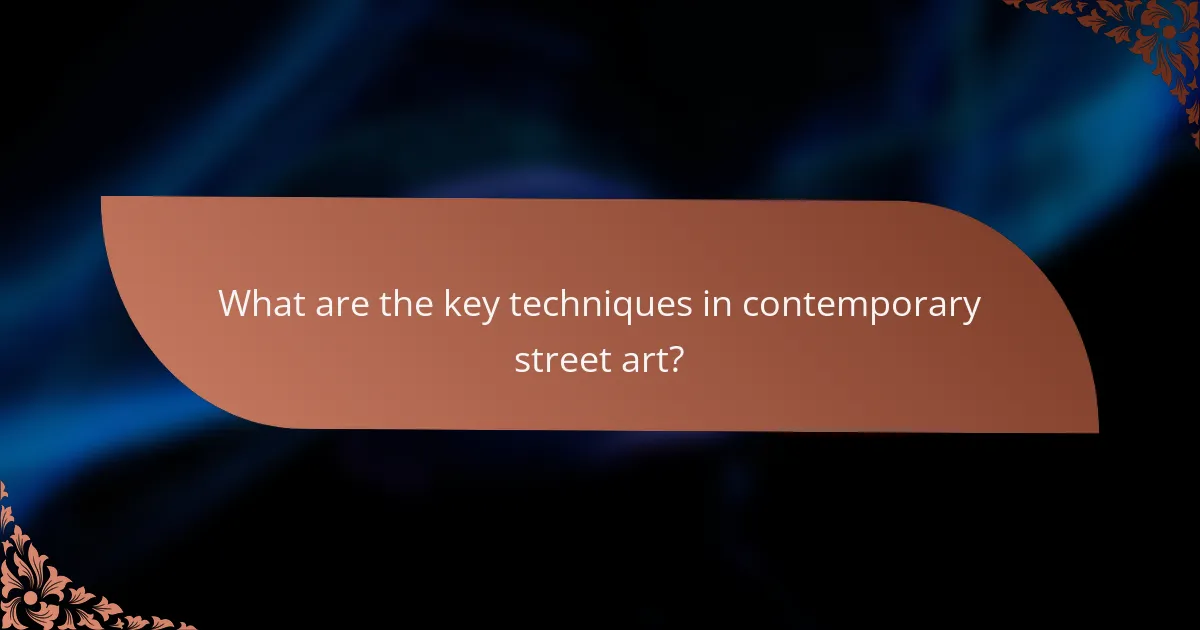
What are the key techniques in contemporary street art?
Contemporary street art employs techniques like stenciling, spray painting, and murals. These methods reflect cultural influences and address social issues, making art accessible in urban spaces. Stenciling allows for quick replication, while murals can transform entire neighbourhoods. Spray painting offers versatility in style and expression, often seen in graffiti. The cultural impact of these techniques fosters community engagement and dialogue.
How do spray painting and stenciling differ in execution?
Spray painting and stenciling differ primarily in technique and execution. Spray painting involves applying paint directly from a can or spray gun, allowing for fluid and spontaneous designs. In contrast, stenciling requires a pre-made template to create defined shapes or patterns, resulting in more precise and controlled artwork.
Spray painting often emphasizes layering and blending colours, while stenciling focuses on sharp edges and specific imagery. This distinction influences the overall aesthetic and impact of the street art produced by each method.
What role does digital technology play in street art creation?
Digital technology significantly enhances street art creation by providing new tools and platforms for artists. Techniques such as digital sketching, projection mapping, and augmented reality allow for innovative expressions. Artists can now reach wider audiences through social media, sharing their work instantly. Additionally, digital tools facilitate collaboration and experimentation, pushing the boundaries of traditional street art. The integration of technology fosters a dynamic cultural impact, making street art more accessible and relevant in contemporary society.
Which emerging techniques are gaining popularity among artists?
Emerging techniques gaining popularity among artists include augmented reality, 3D printing, and interactive installations. These methods enhance viewer engagement and provide innovative ways to express creativity. Augmented reality allows artists to blend digital and physical worlds, creating immersive experiences. 3D printing enables the production of intricate sculptures and installations with precision. Interactive installations invite audience participation, blurring the line between creator and viewer. As a result, these techniques significantly influence contemporary street art, pushing boundaries in artistic expression.
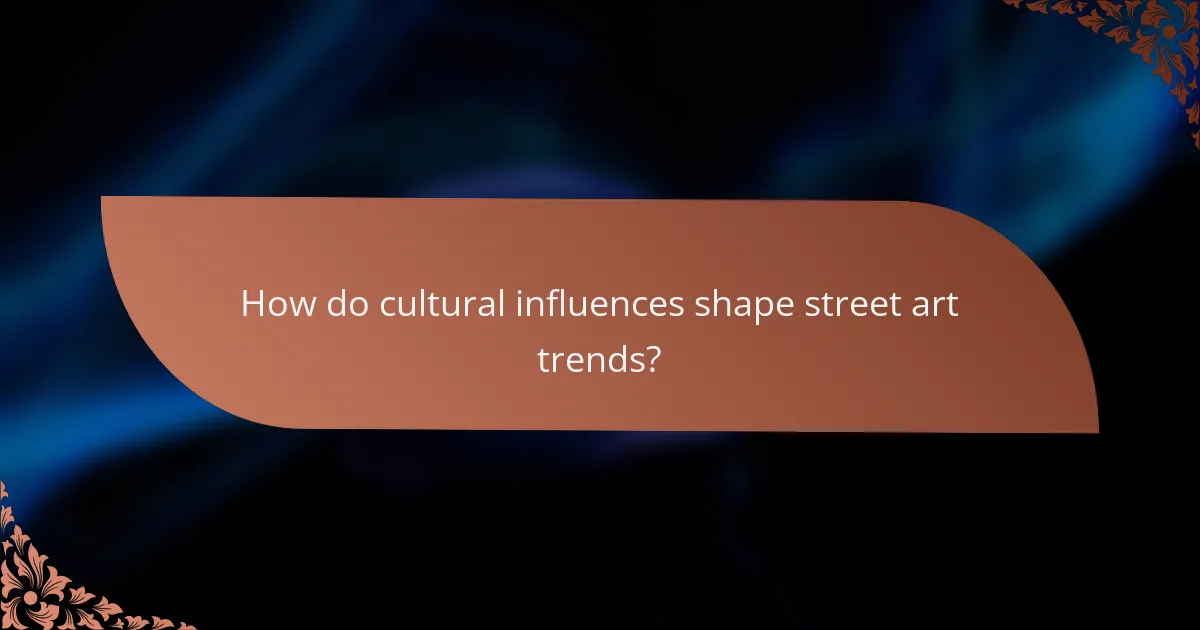
How do cultural influences shape street art trends?
Cultural influences significantly shape street art trends by reflecting societal values, political issues, and local traditions. Artists often draw inspiration from their cultural backgrounds, incorporating symbols and styles unique to their communities. For instance, indigenous motifs can inspire contemporary pieces, creating a dialogue between past and present. Additionally, global movements, such as social justice campaigns, influence themes and techniques used in street art. As a result, street art becomes a canvas for cultural expression and commentary, evolving with each generation.
What impact do local histories have on street art themes?
Local histories significantly influence street art themes by reflecting community narratives and cultural identities. Artists often draw inspiration from historical events, local struggles, and cultural heritage, creating a dialogue between the past and present. For example, murals may depict historical figures or significant events relevant to the area. This connection fosters a sense of belonging and pride among residents. Additionally, unique attributes of local environments, such as architecture and social issues, shape the techniques and styles used in street art. As a result, street art becomes a medium for storytelling, preserving local histories while engaging broader audiences.
How do global events inspire street art movements?
Global events significantly inspire street art movements by reflecting societal issues and cultural shifts. Artists often respond to crises, protests, and celebrations through their work. For instance, political unrest can lead to powerful murals that address injustice, while environmental movements may inspire art promoting sustainability. This dynamic interplay between current events and artistic expression creates a vibrant dialogue in urban spaces. Street art serves as a visual commentary, engaging communities and fostering awareness. As a result, it becomes a tool for social change and cultural reflection.
Which cultural icons are frequently referenced in street art?
Street art frequently references cultural icons like political figures, musicians, and historical events. These representations often convey social messages or critique contemporary issues.
Notable examples include:
– **Banksy**: Utilizes figures like Princess Diana and cultural symbols to provoke thought.
– **Shepard Fairey**: Features icons such as Barack Obama, promoting political awareness.
– **Keith Haring**: Incorporates pop culture symbols to address social issues like AIDS and LGBTQ+ rights.
These icons enhance the cultural relevance and impact of street art, making it a powerful medium for expression.
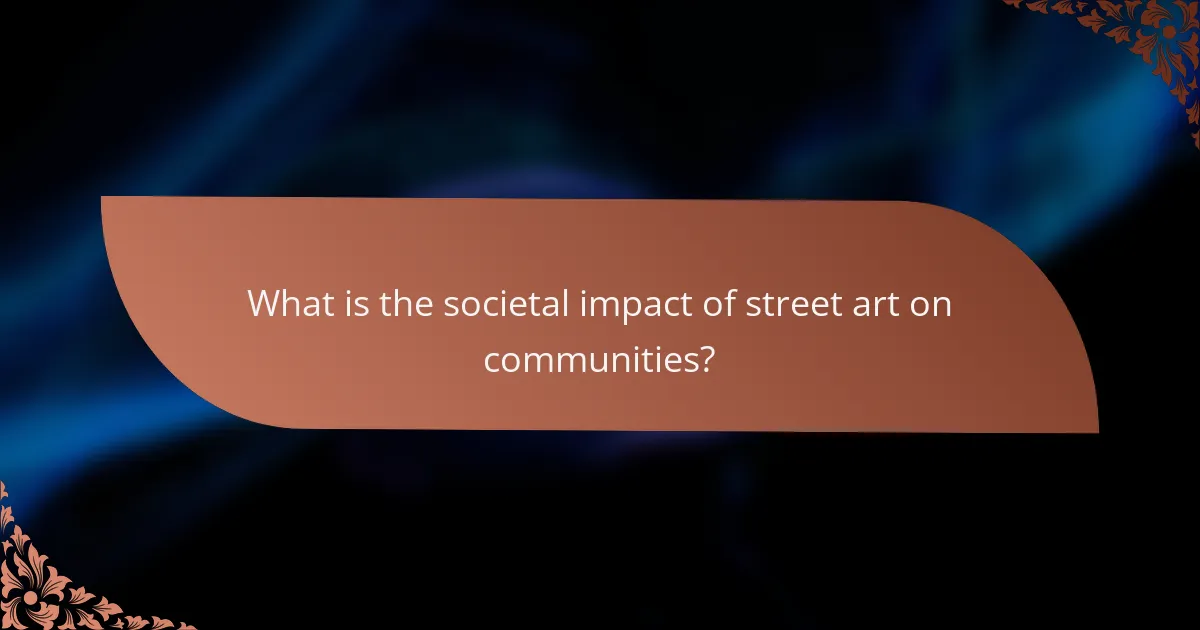
What is the societal impact of street art on communities?
Street art positively impacts communities by fostering creativity, enhancing public spaces, and promoting social dialogue. It often reflects local culture and can drive tourism. Engaging with street art encourages community pride and involvement. Moreover, it can serve as a platform for marginalized voices, addressing social issues and sparking conversations. The unique attribute of street art is its ability to transform neglected areas into vibrant cultural hubs, making art accessible to all.
How does street art contribute to community identity?
Street art significantly enhances community identity by reflecting local culture and values. It fosters a sense of belonging and pride among residents. Vibrant murals and installations often express social issues, history, and collective aspirations. These artworks can unite diverse groups, encouraging dialogue and collaboration. Additionally, street art attracts tourism, boosting local economies and creating a shared space for cultural exchange. Ultimately, it transforms urban landscapes into dynamic representations of community spirit.
What are the benefits of street art in urban regeneration?
Street art significantly benefits urban regeneration by enhancing community identity, attracting tourism, and fostering local economic growth. It transforms neglected spaces into vibrant cultural hubs, encouraging social interaction and community pride. Additionally, street art often addresses social issues, sparking dialogue and reflection among residents. As a result, cities with active street art scenes experience improved public perception and increased investment in local businesses.
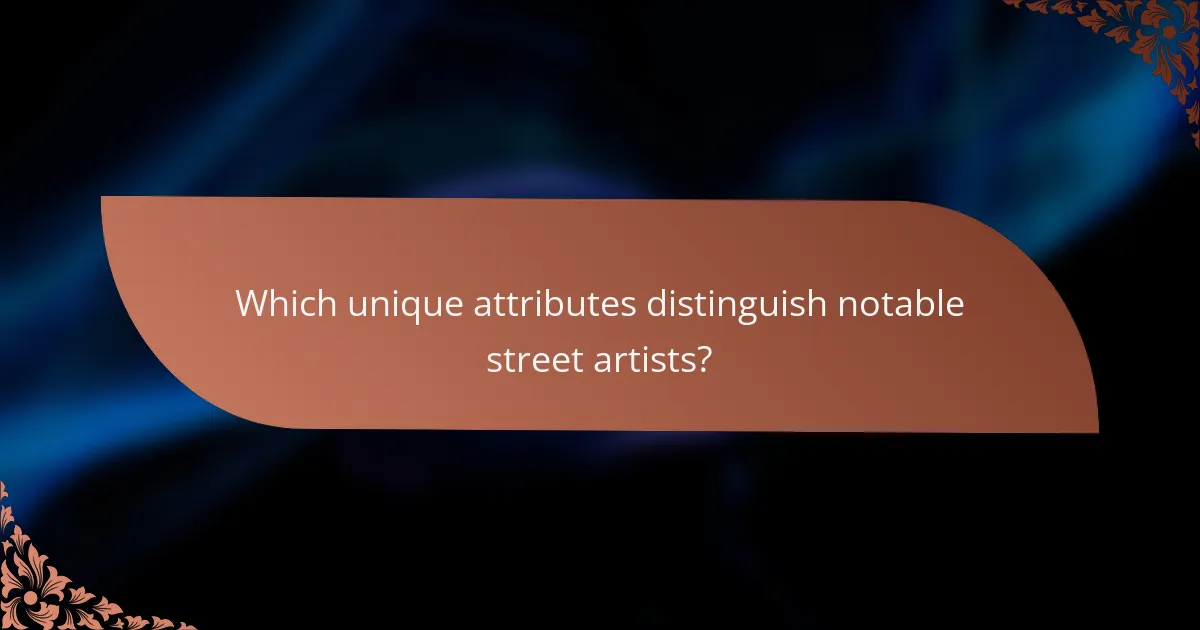
Which unique attributes distinguish notable street artists?
Notable street artists are distinguished by their unique attributes, including innovative techniques, cultural commentary, and distinct visual styles. These artists often blend various mediums, such as spray paint, stencils, and digital art, to create impactful works. Their ability to engage with social issues and local communities further sets them apart, making their art resonate on multiple levels. Additionally, a unique attribute of some artists is their use of unconventional materials, which can enhance the storytelling aspect of their work.
How do personal backgrounds influence an artist’s style?
Personal backgrounds significantly shape an artist’s style by influencing their perspectives and techniques. Cultural heritage, socio-economic status, and personal experiences create unique artistic expressions. For instance, street artists often reflect their community’s struggles and triumphs through their work. This connection to personal history fosters authenticity and resonance with audiences. Additionally, exposure to diverse artistic movements can lead to innovative techniques and styles, enriching the overall street art landscape.
What are the signature techniques of renowned street artists?
Renowned street artists employ signature techniques that define their unique styles. These techniques include stenciling, spray painting, wheat-pasting, and mural painting.
Stenciling allows for precision and repetition, often used by artists like Banksy. Spray painting offers vibrant colours and fluidity, seen in the works of Shepard Fairey. Wheat-pasting involves adhering printed images to surfaces, popularized by artists like JR. Mural painting emphasizes large-scale imagery and community engagement, exemplified by artists such as Os Gêmeos.
These techniques reflect the cultural impact of street art, influencing urban aesthetics and social commentary.
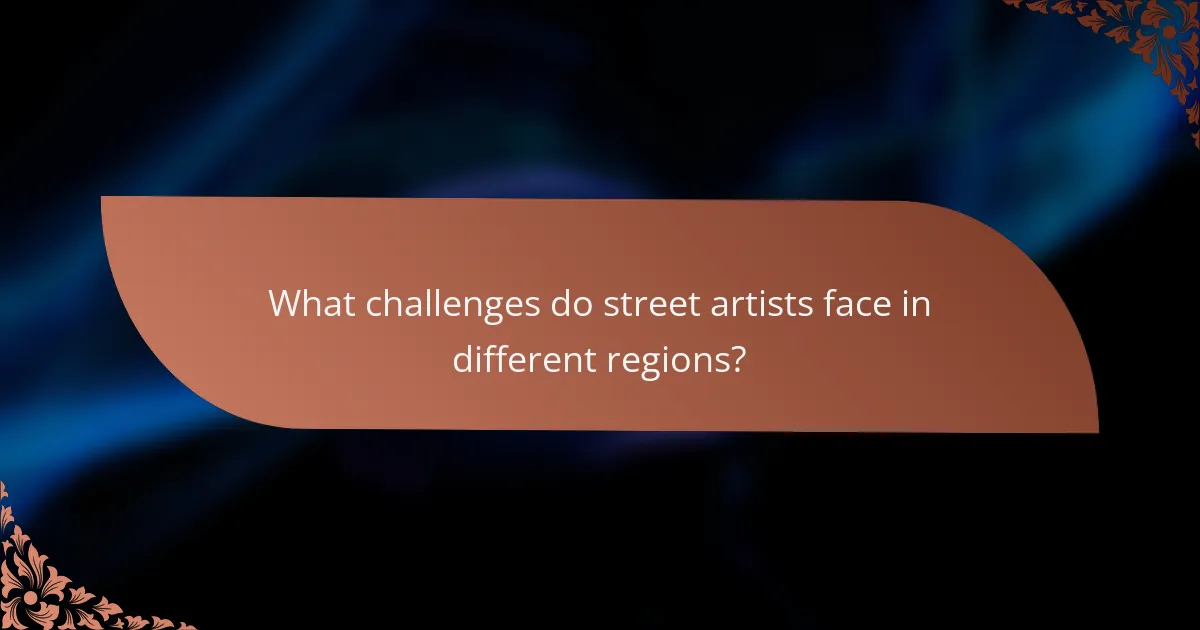
What challenges do street artists face in different regions?
Street artists face various challenges across different regions, including legal restrictions, cultural acceptance, and resource availability. In some areas, strict laws against graffiti hinder artistic expression. Cultural perceptions can also vary; in certain regions, street art is celebrated, while in others, it is viewed as vandalism. Limited access to materials and public spaces further complicates the work of street artists, impacting their ability to create and share their art effectively.
How do legal restrictions affect street art in urban spaces?
Legal restrictions significantly limit street art in urban spaces by imposing penalties for unauthorized works. These laws often lead to decreased visibility and accessibility for artists. As a result, many street artists adapt their techniques to comply with regulations, shifting towards legal murals or sanctioned projects. Unique attributes of street art, such as its ephemeral nature, become rare in heavily regulated environments. Legal frameworks can stifle creativity, impacting the cultural significance of street art in communities.
What role does public perception play in the acceptance of street art?
Public perception significantly influences the acceptance of street art. Positive views can elevate street art from vandalism to a respected art form. Community engagement and cultural relevance enhance its legitimacy. Conversely, negative perceptions may lead to resistance and calls for removal. Public opinion often shapes policies regarding street art, impacting its visibility and funding.
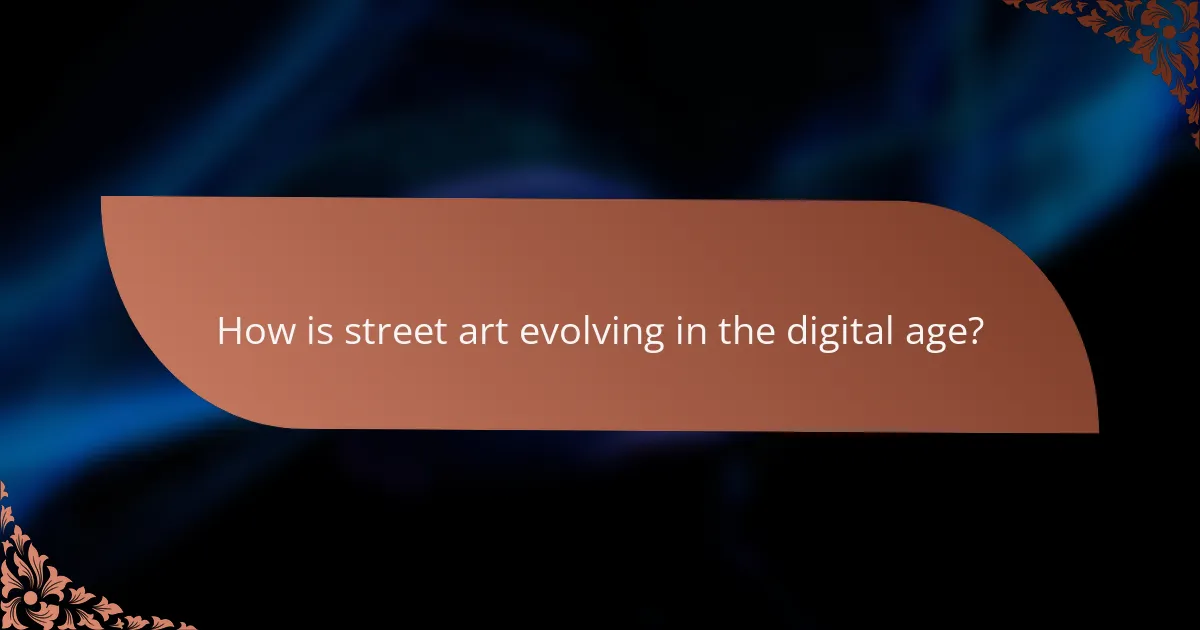
How is street art evolving in the digital age?
Street art is evolving through digital platforms, enhancing visibility and interaction. Artists now utilize social media and augmented reality to reach broader audiences. Techniques like digital projection and interactive murals are gaining popularity, allowing for dynamic expressions. Cultural influences from global movements and technology are reshaping themes and styles, fostering a more inclusive art scene.
What platforms are most effective for promoting street art online?
Social media platforms are the most effective for promoting street art online. Instagram, Facebook, and Pinterest allow artists to showcase their work visually and engage with audiences. These platforms facilitate community building and sharing, enhancing visibility. TikTok is emerging as a dynamic space for street art videos, capturing trends rapidly. Each platform’s unique attributes cater to different aspects of street art promotion, from visual storytelling to interactive content.
How do social media trends influence street art styles?
Social media trends significantly shape street art styles by promoting visibility and facilitating collaboration among artists. Platforms like Instagram allow artists to showcase their work, leading to viral trends that influence techniques and themes.
Artists often adopt popular aesthetics, such as bold colours or specific motifs, to gain traction online. This phenomenon fosters a unique blend of traditional street art with digital influences, creating a dynamic cultural dialogue.
Moreover, the immediacy of social media encourages rapid experimentation, resulting in diverse styles that reflect current social issues. As a result, street art becomes a responsive medium, adapting to the evolving landscape of online culture.
The interaction between social media and street art highlights the importance of digital engagement in contemporary artistic expression.
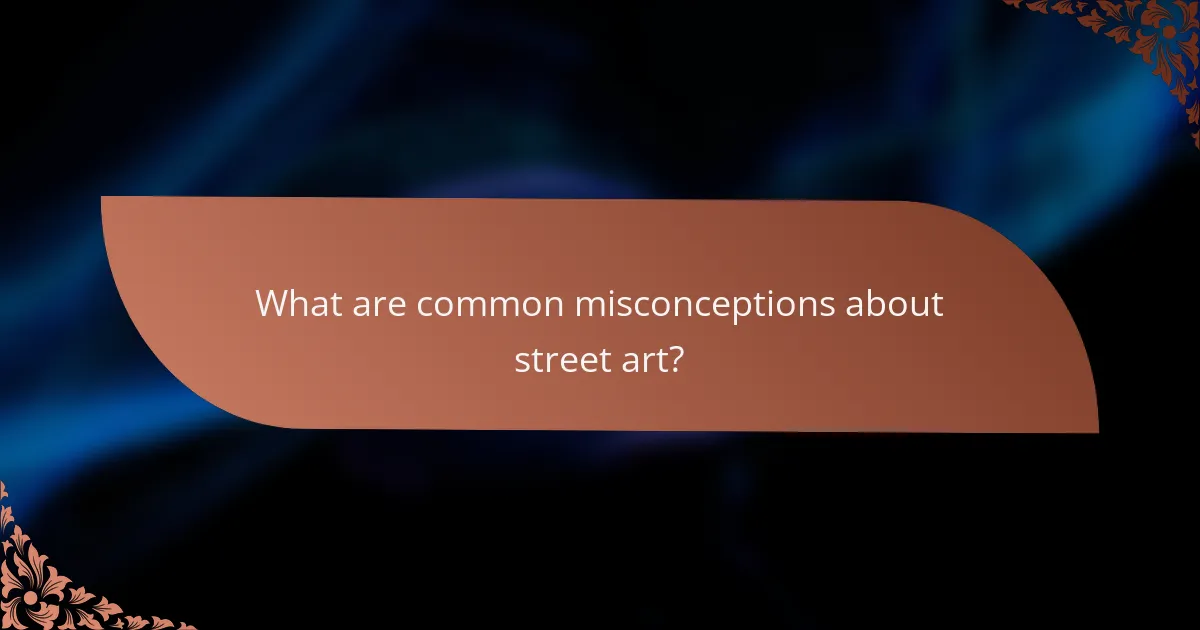
What are common misconceptions about street art?
Many misconceptions about street art include viewing it solely as vandalism, believing it lacks artistic value, or assuming it is only created by rebels. Street art is often a legitimate form of expression, showcasing creativity and cultural commentary. It can also enhance public spaces and foster community engagement. Additionally, the diversity of techniques and influences in street art, such as stencil, mural, and graffiti, illustrates its complexity and significance in contemporary culture.
Why do some people view street art as vandalism?
Some people view street art as vandalism due to its unauthorized nature and potential to deface property. This perception often stems from the legal implications surrounding graffiti and murals. Many consider street art a form of rebellion against societal norms, leading to mixed opinions on its value. Cultural context plays a significant role; in some communities, street art is celebrated, while in others, it is seen as a nuisance. The distinction between art and vandalism often hinges on the location, artist intent, and community acceptance.
How does street art differ from traditional forms of art?
Street art differs from traditional forms of art primarily in its accessibility and context. Street art is often created in public spaces, making it more visible and engaging to a wider audience. Traditional art typically resides in galleries or museums, limiting its exposure.
Street art employs techniques like spray painting, stenciling, and wheat-pasting, which contrast with traditional methods such as oil painting or sculpture. Influences on street art include urban culture, social issues, and community engagement, while traditional art often reflects historical or classical themes.
Culturally, street art serves as a platform for activism and expression, challenging societal norms. In contrast, traditional art tends to focus on aesthetics and craftsmanship, often detached from immediate social commentary. This distinction highlights street art’s unique attribute of being a voice for the marginalized, making it a dynamic and evolving form of expression.
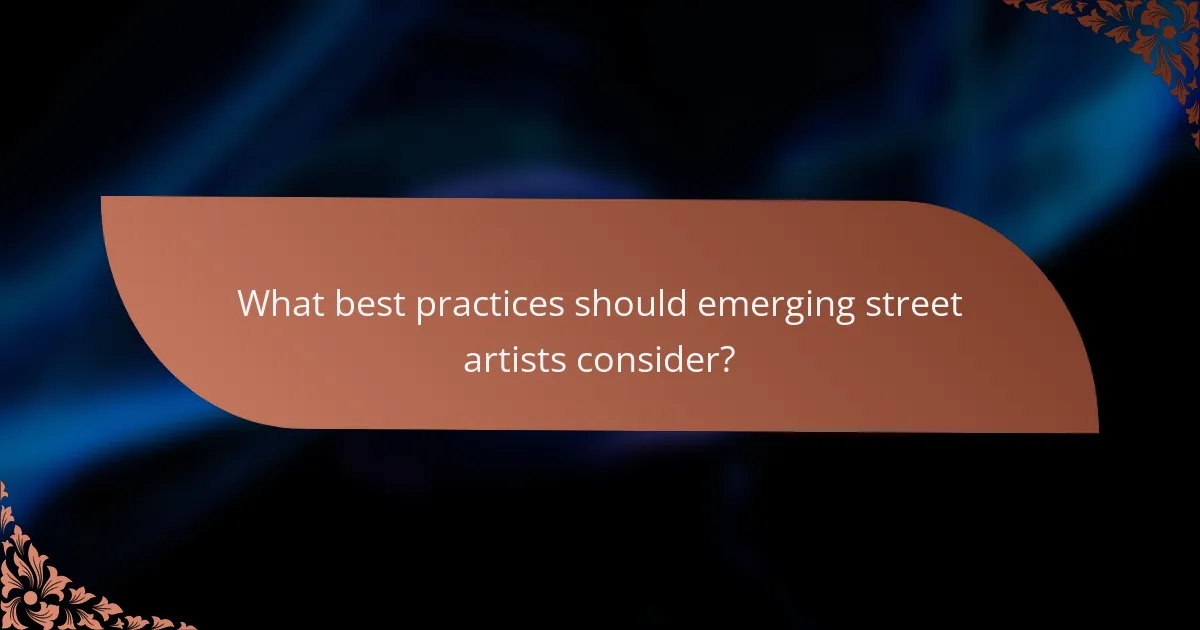
What best practices should emerging street artists consider?
Emerging street artists should focus on authenticity, community engagement, and continuous learning. Authenticity helps establish a unique voice in a crowded space. Engaging with the local community fosters connections and creates meaningful art. Continuous learning through workshops or online resources enhances skills and keeps artists updated on trends. Networking with other artists can also provide valuable insights and collaboration opportunities.
How can artists effectively engage with their local communities?
Artists can effectively engage with their local communities by utilizing street art to foster connections and inspire dialogue. They can create murals that reflect local culture, address social issues, and promote community pride. Collaboration with local organizations enhances visibility and support for their work. Hosting workshops encourages public participation and skill sharing, building stronger community ties. Additionally, artists can leverage social media to share their projects and gather community feedback, further solidifying their relationships with local audiences.
What strategies help in building a recognizable street art brand?
To build a recognizable street art brand, focus on unique artistic style and consistent messaging. Develop a signature technique that reflects personal identity. Engage with local communities to create a loyal following. Utilize social media for visibility and interaction, showcasing work and behind-the-scenes processes. Collaborate with other artists to expand reach and influence.
